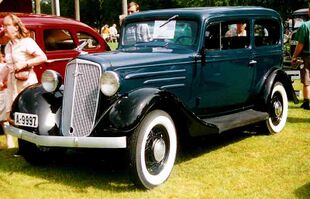Engineering:Chevrolet Standard Six
| Chevrolet Standard Six | |
|---|---|
 | |
| Overview | |
| Manufacturer | Chevrolet (General Motors) |
| Also called | Chevrolet Mercury (1933 only) |
| Production | 1933 (Mercury) 1934–1936 (Standard) |
| Assembly |
|
| Body and chassis | |
| Body style |
|
| Layout | FR layout |
| Platform | GM A platform |
| Related | Chevrolet Master Pontiac Six |
| Powertrain | |
| Engine | 181 cu in (3.0 L) OHV I6 206.8 cu in (3.4 L) OHV I6 |
| Transmission | 3-speed manual[1] |
| Dimensions | |
| Wheelbase | 107.0 in (2,718 mm) 109.0 in (2,769 mm)(1936)[2] |
| Chronology | |
| Predecessor | Chevrolet Series BA Confederate |
| Successor | Chevrolet Master |
The Chevrolet Standard (Series DC) was launched in 1933, initially as the Chevrolet Standard Mercury, by Chevrolet as a lower priced alternative to the 1932 Chevrolet Series BA Confederate that became the Master Eagle in 1933[3] and Master from 1934.[4] It was advertised as the cheapest six-cylinder enclosed car on the market.[5]
The Standard was offered in three body styles all on a 107-inch wheelbase: 2-door sedan (a body style Chevrolet customarily referred to as a "coach" in marketing at the time), coupe and coupe with rumble seat. All bodies were by Fisher and featured 'no-draft ventilation'. All models were powered by a 181 cu in (2,970 cc) six-cylinder valve-in-head engine producing 60 bhp (45 kW; 61 PS) at 3,000 rpm and 125 lb⋅ft (169 N⋅m) of torque[6] giving the car a top speed of between 65 and 70 mph. This engine had first appeared in Chevrolet's 1929 models, introduced in 1928. The car had full instrumentation.[7] A clock, heater and a radio were options.[1] For 1934, sedan, roadster and touring body styles were added to the catalog.
In 1935, a larger 206.8 cu in (3,389 cc) six-cylinder engine was offered in lieu of the 181 cu in (2,970 cc), producing 74 bhp (55 kW; 75 PS) at 3,200 rpm and 150 lb⋅ft (203 N⋅m) of torque. A sedan delivery was also available this year.
For 1936, the Standard Six received a wide range of improvements and a wider choice of body styles including cabriolet and sports sedan versions. It was built on a new box-girder frame with a wheel base of 109 inches.[8] With an increase of compression ratio from 5.6:1 to 6:1, the standard 206.8 cu in (3,389 cc) engine now produced 79 bhp (59 kW; 80 PS) at 3,200 rpm and 156 lb⋅ft (212 N⋅m) of torque which was now shared with the Master Six.[9] The spare wheel moved from its external rear trunk location to a new compartment under the trunk. Brakes were 11-in drums.[2] The steel roof was new.[10]
The Standard Six was discontinued for 1937 when the Master range was joined by the new Master Deluxe.[11] In May 1925 the Chevrolet Export Boxing plant at Bloomfield, New Jersey was repurposed from a previous owner where Knock-down kits for Chevrolet, Oakland, Oldsmobile, Buick and Cadillac passenger cars, and both Chevrolet and G. M. C. truck parts are crated and shipped by railroad to the docks at Weehawken, New Jersey for overseas GM assembly factories.[1]
See also
- 1933 Cadillac Series 355
- 1933 LaSalle Series 303
- 1933 Oldsmobile F-Series
- 1933 Buick Series 50
- 1933 Pontiac
References
- ↑ 1.0 1.1 1.2 Kimes, Beverly R. (1996). Clark, Henry A.. ed. The Standard Catalog of American Cars 1805-1945. Kraus Publications. pp. 283–302. ISBN 0873414780.
- ↑ 2.0 2.1 "Directory Index: Chevrolet/1936_Chevrolet/1936_Chevrolet_Brochure". Oldcarbrochures.com. http://www.oldcarbrochures.com/static/NA/Chevrolet/1936_Chevrolet/1936_Chevrolet_Brochure/1936%20Chevrolet-15.html.
- ↑ "1933 Chevrolet Eagle and Mercury". How Stuff Works. http://auto.howstuffworks.com/1933-chevrolet-eagle-and-mercury.htm.
- ↑ "GM Heritage Center 1933 information sheet". http://www.gmheritagecenter.com/gm-heritage-archive/docs/Chevrolet/1933-Chevrolet.pdf.
- ↑ The Tuscaloosa News - Mar 12, 1933 pg11
- ↑ "GM Heritage Center 1935 information sheet". http://www.gmheritagecenter.com/gm-heritage-archive/docs/Chevrolet/1935-Chevrolet.pdf.
- ↑ "1934 Chevy Owner's Manual". Chevy.oldcarmanualproject.com. http://chevy.oldcarmanualproject.com/chevyowner/34om15.htm.
- ↑ "GM Heritage Center 1936 information sheet". http://www.gmheritagecenter.com/gm-heritage-archive/docs/Chevrolet/1936-Chevrolet.pdf.
- ↑ "1936 Chevrolet Standard and Master Deluxe". Auto.howstuffworks.com. http://auto.howstuffworks.com/1936-chevrolet-standard-and-master-deluxe.htm.
- ↑ "Directory Index: Chevrolet/1936_Chevrolet/1936_Chevrolet_Brochure". Oldcarbrochures.com. http://www.oldcarbrochures.com/static/NA/Chevrolet/1936_Chevrolet/1936_Chevrolet_Brochure/1936%20Chevrolet-14c.html.
- ↑ "1937-1939 Chevrolet". Auto.howstuffworks.com. 2007-09-19. http://auto.howstuffworks.com/1937-1939-chevrolet1.htm.
 |


